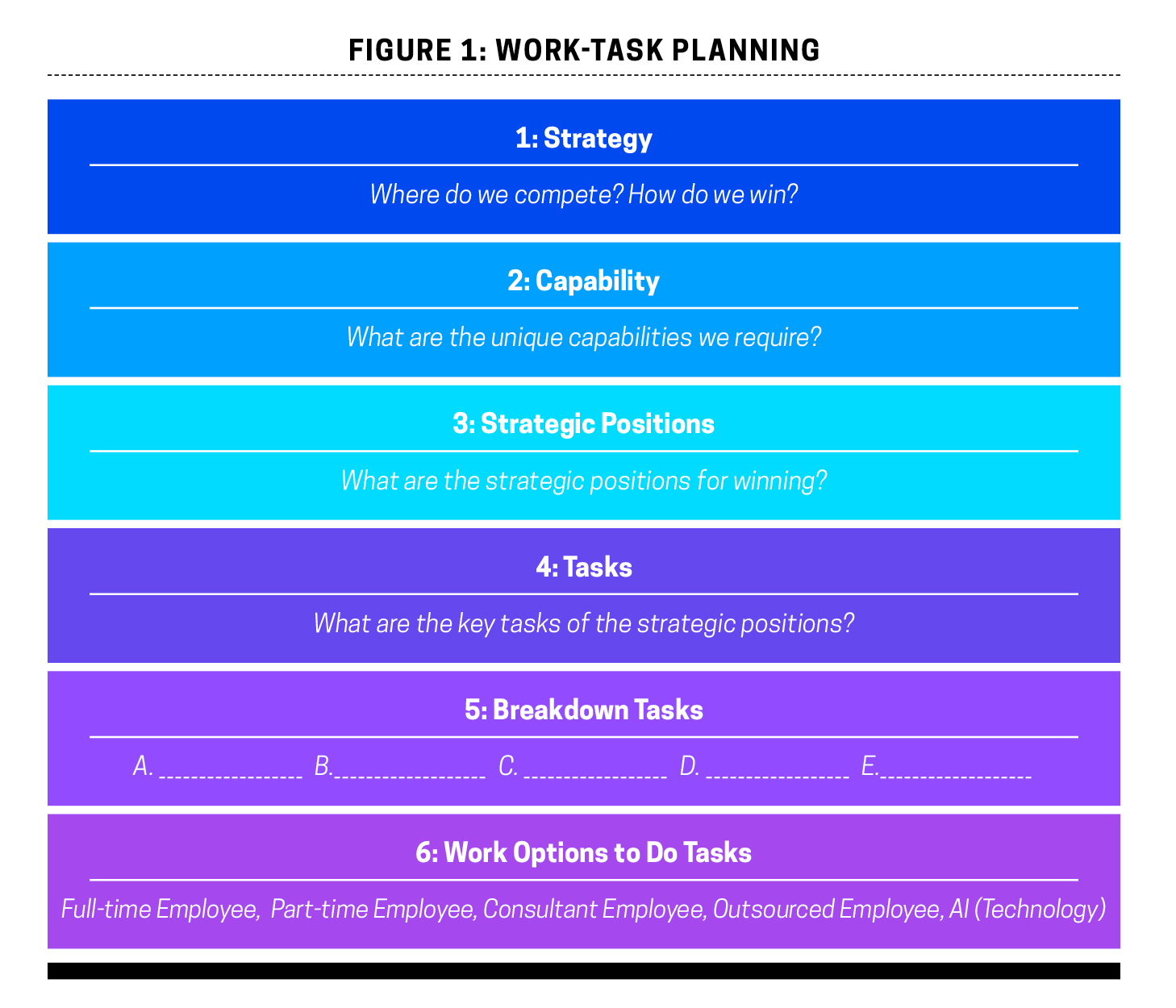Out: Building the ideal workforce. In: Putting the right team together to accomplish tasks that help the organization grow.
By Dave Ulrich
Everyone realizes that better talent (and culture) will help an organization succeed. Over the years, many have attempted to improve talent—this effort is loosely called workforce planning.
- Markov chains helped forecast headcount requirements given the probability of retirements, turnover, promotions, and transfers.
- Competency models moved beyond headcounts to skills required given a particular business strategy.
- Organization capability models aligned individual skills into collective organization capabilities (or culture) that would win in the marketplace.
- Leaders identified strategic positions as those that would create wealth for the firm through increasing revenue or decreasing costs, impact firm’s customers, and have variability on performance. They could then make plans to align talent to these key positions.
All of this and related efforts focus on the “workforce” and define talent as people (headcount, individual competencies, collective capabilities, and strategic positions). Through workforce plans, talent management systems help businesses define, source, orient, improve, and motivate employees.
Today’s work world sees an onslaught of technological innovation. The speed and power of computing increases, producing digital concepts that include cloud and big data, social media, gamification, internet of things, robots and chatbots, virtual or augmented reality, blockchain, artificial intelligence, cognitive automation, machine learning, deep learning, and more. Through these digital tools, the use of technology has evolved from focused reasoning to statistics to deep neural learning systems. When technology can mimic the brain function, machines can even create deep learning.
The human brain is wired with about 100 billion neurons and 100 trillion synapses. Computers currently have approximately 1 billion synapses—not close to human brain capacity. Thus, technology is an assistant (enabler, supporter, partner, helper) and not a replacement for people. Though it will not match neurological brain power, as technology evolves, it will have the capacity to use data to make decisions and to learn (e.g., IBM’s “Watson” learned to play chess as well as or better than a human being).
What does technological and digital revolution have to do with workforce planning? In today’s companies, work can be accomplished in many ways: by full-time employees, part-time employees, contract employees (outsourced, consultants), and now AI (robots, augmented reality, machine learning).
With this variety of ways of doing work (including technology), the focus of talent management is less on planning a workforce than on accomplishing work-tasks. The logic of work-task planning has seven steps, as shown in Figure 1.

Summary of Steps to Work-Task Planning
1. Create strategic clarity. Strategy is about gaining consensus and clarity around 1) where we are going to compete (e.g., industry, market, customers), and 2) how we will compete (e.g., price, product, customer intimacy).
2. Define desired organization capabilities. What are the capabilities we require to be competitive over time (e.g., information asymmetry, customer service, innovation, agility)?
3. Specify strategic positions. What are the key roles or positions in the company that will deliver value to customers in unique ways?
4. Describe the key tasks of the strategic positions. What does the role or strategic position do?
5. Decompose tasks into specific activities. What are the key activities of accomplishing the tasks? Delineate these tasks in terms of specific behaviors or actions.
6. Identify alternative ways of doing these tasks. Recognize and identify the work options for accomplishing the specific tasks: full-time, part-time, consultant, outsource, or technology (AI).
7. Match work-tasks with work options. Fill in the matrix, identifying which tasks could be accomplished by which work options. Create the criteria for designating the way tasks could be accomplished by asking questions about each task. For example, does this task:
- Link to strategic or essential work?
- Require proprietary or generic skills?
- Entail optimal or satisficing results?
- Emphasize insight/creativity or efficiency?
- Call for unique solutions or standardized responses?
Using this logic, decomposed tasks (A, B, C, and so on in the figure) that require strategic, proprietary, optimal, insightful, and unique solutions are more likely to be done by full-time employees who become a source of strategic differentiation. Tasks that are characterized as essential, generic, satisficing, efficient, and standardized may be done through automation with technology-enabled solutions. Part-time, consultant, and outsourced employees will perform a mix of the types of work-tasks.
Decomposing tasks and adding AI as a possible provider of the work changes workforce planning (people) to work-task planning (task accomplishment).
Work-task planning may affect almost any industry going through transformation. Hospitality industries (Airbnb as well as traditional hotel chains) may use AI for guests to select, register, and check out of lodgings. Hailing and contracting for driving options (e.g., Uber, Lyft) may be scheduled through blockchain information. Big-box retail stores may have automated supply chain, stocking, and check out. Quick service (and other) restaurants may have automated ordering, food preparation, serving, and cleaning. E-commerce with smart retailing already uses big data to tailor to customer needs through order and delivery.
Other industries (healthcare, education, manufacturing, financial services, and so forth) could also shift to work-task planning to more efficiently define and deliver tasks.
This new approach to work does not discount people but relies on people for strategic, creative, and unique tasks. Removing the more routine and standard tasks to technology and automation increases employee well-being, customer service, and investor confidence.
HR professionals need to broaden their talent management horizon to recognize that work is not just accomplished by full-time, part-time, or contracted people, but also through automation and technology. Most of us have experienced early versions of the work-task logic when we fill our car with gas. Most have become accustomed to self-service rather than relying on people service in this instance.
The work-task logic presented above magnifies this gasoline self-service approach many times over, making the next phase for accomplishing work exciting to anticipate.
Dave Ulrich is the Rensis Likert Professor at the Ross School of Business at University of Michigan and a partner at The RBL Group, a consulting firm focused on helping organizations and leaders deliver value. He studies how organizations build capabilities of leadership, speed, learning, accountability, and talent through leveraging human resources. He has helped generate award-winning databases that assess alignment between strategies, organization capabilities, HR practices, HR competencies, and customer and investor results.


